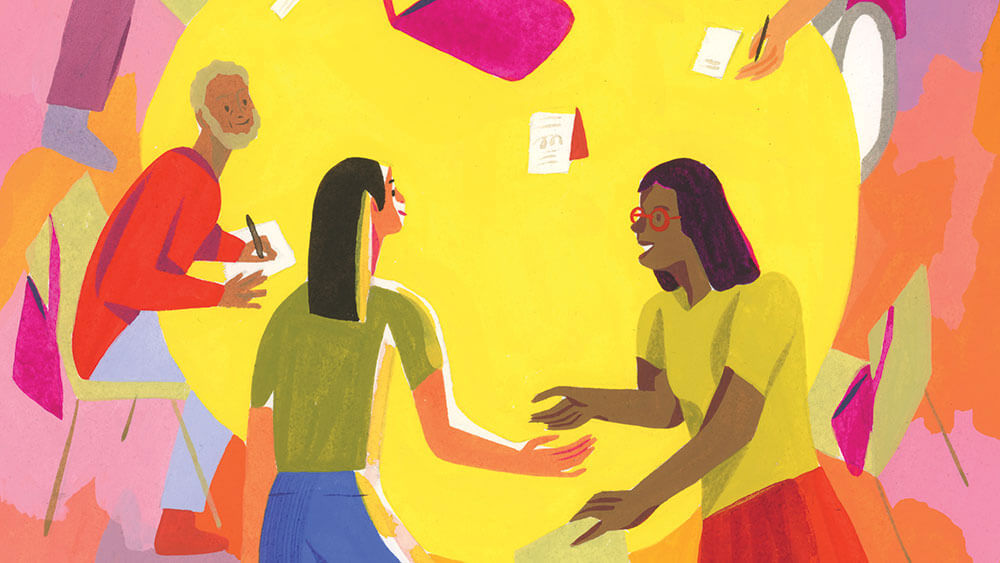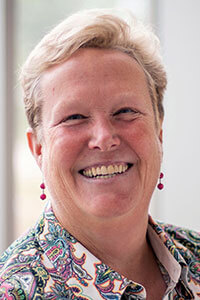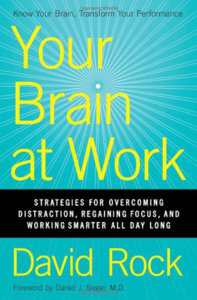
Face-to-face meetings are helping reverse the worldwide problem of loneliness. (Illustration by Ping Zhu)
It’s been almost two decades since political scientist Robert Putnam used bowling alone as a metaphor to illustrate the unraveling of social ties in the United States. As Putnam wrote in his 2000 book, Bowling Alone: The Collapse and Revival of American Community, although more people were bowling in the United States in the 1990s than ever before, compared to previous decades, more of them went bowling on their own rather than bowling together in leagues. People also were eating fewer family dinners together, he wrote, belonged to fewer organizations, and were having fewer friends over to their houses.
Deteriorating community connections could lead to the weakening of democratic institutions and the erosion of trust among Americans, warned Putnam, a professor of public policy at Harvard University. And it could speed our deaths, he wrote — just belonging to one organization can cut the risk of mortality nearly in half.
In the 20 years since Bowling Alone was published, our social ties have continued to fray, so much so that public policy and health experts have described loneliness as an epidemic.
A study released last year by Cigna, the health-care company, found that only around half of Americans — 53 percent — have meaningful in-person social interactions on a daily basis, and 43 percent of respondents reported that they feel isolated from others. Loneliness often is associated with the elderly, but the youngest group surveyed, Generation Z, ages 18-22, reported the highest levels of loneliness.
Meanwhile, the recognition of the dangers that social isolation poses is also growing. Loneliness has been associated with poor sleep, anxiety and depression, lowered immune and cardiovascular system functioning, cognitive decline, and death. Dr. Vivek H. Murthy, former U.S. surgeon general — who has spoken about his own experiences with loneliness — compared the risks of social isolation to smoking, associated with a reduction in lifespan similar to that caused by smoking 15 cigarettes a day, an even greater risk than that associated with obesity.
And it is a global problem, not just an American one. In January 2018, Prime Minister Theresa May appointed a Minister of Loneliness following a report co-sponsored by the British Red Cross that more than nine million people in the country — or one of five — “often or always” feel lonely. In
Related: CreativeMornings: A Global Community Built on Connection
Norway, which ranked third in the United Nations Sustainable Development 2019 World Happiness Report, 16 percent of the population reported that they are “haunted by loneliness every day,” according to Karen Dolva, CEO and co-founder of No Isolation, a Norwegian startup that makes connection a priority.
It is a problem with a solution, although not a simple one. “The feeling that you’re not alone changes how you process the whole world,” said speaker and researcher Michelle Gielan, a former broadcast journalist who has a master’s degree in applied positive psychology from the University of Pennsylvania and is a founder and researcher at the Institute of Applied Positive Research. Social connections — ones with breadth, depth, and meaning — are the greatest predictors of our long-term happiness, she said. “Any time we make an investment in social connection, we not only combat loneliness, but we feed our success at the same time,” she told Convene in a telephone interview.

Michelle Gielan
Gielan lays part of the blame for our disconnection with one another on our increasing reliance on electronic, rather than face-to-face, communication in our work lives. We are spending more time alone, either holed up in our offices or working remotely, she said. “We might think that we are increasing our productivity, [but] oftentimes email creates greater levels of misunderstanding. We are left feeling more disconnected from a person that we might work with regularly, as opposed to connected.”
The “other pieces are social media and the news media in general,” said Gielan, the author of Broadcasting Happiness: The Science of Igniting and Sustaining Positive Change. “We see all these examples of how people’s lives are so perfect and amazing, as people put out their best face on social media. And sometimes that makes us feel ‘less than’ about our own lives — and ultimately, I think, it disconnects us. It doesn’t allow us to feel authentic and vulnerable as we talk with others or share our experiences.”
Born to Connect
“As humans, as mammals, we need to be with others — we are born with an innate, deep need for connection,” said Janet Sperstad, CMP, program director of the meeting and event management degree at Madison College. Sperstad, a former event planner, has a master’s degree in neuroleadership, which combines neuroscience with areas including leadership development, management training, and education.
Technology can’t replace human interaction, Sperstad said. “We’ve evolved as people because we have been with others. We take our social cues from others,” she said. “We like to say that technology is disruptive, but what we are also talking about is that technology is disruptive to human health.

Janet Sperstad
“Whether you do a Zoom call or a webinar, you’re still interacting with inanimate objects and our senses know that,” she added. “Our senses bring in so much of our information. We need to be connected so we can calibrate and understand who we are, where we are, and where we are in relation to others.”
Face-to-face events to the rescue — but not so fast. Simply putting people in proximity of one another won’t, on its own, build social connections. John Cacioppo, who founded the University of Chicago’s Center for Cognitive and Social Neuroscience, made a distinction between “objective isolation,” meaning that people are objectively alone, and “perceived isolation,” where people feel like they are alone, even when they are surrounded by others. Of the two, Cacioppo’s research showed, perceived isolation is more harmful.
So while events may gather people for the purpose of creating learning opportunities and forging connections, there are specific approaches organizers can take to combat perceived loneliness, to help attendees forge real connections with each other. Here are a few:
• Dial up the sense of belonging. In workshops that Sperstad teaches on neuroscience and leadership, she makes the point that our brains treat social interactions using the same processes that operate when our physical survival is threatened. (See “Talk to Your Attendees’ Subconscious,” p. 48.) “Events are social landmines,” Sperstad said. “We want to know whether we belong or don’t belong, whether we are in the in crowd, or the out crowd, whether we are doing the same things that others are doing, or not.”
• Reduce uncertainty. Uncertainty ignites the threat response, in the same way as when you are in physical danger, she said. “And what you want to do when you’re under threat is isolate yourself and protect yourself.” Our brains are constantly trying to predict what’s going to happen to keep us safe and maximize our opportunities and rewards, Sperstad said. Simple actions like making schedules available in apps, allowing people to download registration confirmations, or working to make it easy for people to find their way to sessions, decrease uncertainty and increase predictability and minimize the amount of social threat at events.
• Create connections. When Gielan has been to events “where you’re sort of thrown into the ring, where you don’t know anybody, and there’s no common ground to start from, that’s really not fun,” she said. “Even if there is an opening lunch, when you get your table number and you go sit down, if you don’t know anybody, it can feel really awkward.”
When Gielan speaks at conferences and events, she introduces an interactive experience within four minutes of the beginning of her talk. “It’s a three-minute icebreaker I’ve developed. I ask them to partner up and then do a handful of quick activities together,” she said. “It’s really just to get
Related: Choral Cure: What Happens When We Sing Together
[participants] to momentarily connect, to puts their brains in a positive state. When your body is flooded with dopamine, your learning centers are activated,” she said. “Most importantly, it’s a chance for attendees to meaningfully connect ever so briefly with the person next to them. They’ve built a little bit of social connection, and hopefully will feel more comfortable as they listen to the rest of the talk.”
The good news for event planners, Gielan said, is that there are unlimited opportunities for them to create experiences for people to share together and help them connect.At one conference where Gielan spoke, organizers asked attendees a few questions in advance about themselves, and at the event, gave them nametags with colored dots tied to their responses. The organizer told attendees, and invited those with like-colored dots to be investigators and try to figure out what it was that they had in common, Gielan said.
• Facilitate social-impact activities. Don’t underestimate the power of happy hour, Gielan said, “but take it beyond cocktails whenever possible.” Gielan once was the first speaker of the day at a corporate event where attendees, who all worked for the same company but in different cities, had spent the previous night serving dinner at a homeless shelter. “Their energy,” she said, “was in a different stratosphere.”
There is something about doing things in a community that changes the whole experience, Gielan said. “Both for me and for participants. There are a million, I mean a million, wonderful TED talks and other resources online, but there’s something about coming together that changes how we process the information.”“What we create in the event space are experiences for people,” Sperstad said. “We’re talking about helping people have a deeper connection — not education, because we can get that digitally. We’re the antidote to this problem of separation.”
Talk to Your Attendees’ Subconscious
David Rock, a leadership coach and a founder of the NeuroLeadership Institute in New York City, once was invited by a friend to a party at a beautiful downtown loft, where the hosts were serving good food, music, and lots to drink. But he was alone among strangers, and “my threat level was off the charts,” he said. It wasn’t until his friend showed up and began to introduce him to other guests that he began to calm down, Rock wrote in his book, Your Brain at Work.
 In his writing and teaching, which applies the findings of neuroscience to leadership, education, and training, Rock has identified five areas in our social experience to which our brains react as if they were survival issues — status, certainty, autonomy, relatedness, and fairness, or the SCARF model. Rock developed SCARF as a way of remembering to address our largely unconscious reactions to what our brains perceive as threats in work settings.
In his writing and teaching, which applies the findings of neuroscience to leadership, education, and training, Rock has identified five areas in our social experience to which our brains react as if they were survival issues — status, certainty, autonomy, relatedness, and fairness, or the SCARF model. Rock developed SCARF as a way of remembering to address our largely unconscious reactions to what our brains perceive as threats in work settings.
The SCARF model is a great tool for event organizers, said Janet Sperstad, CMP, who uses the concepts in workshops she teaches on neuroleadership. Many things that organizers do at events already address the social side of our experience, Sperstad said. The model could help event organizers think more deeply about questions, including, “How am I connecting people? How am I creating certainty?” Here’s what to keep in mind:
Status — Where you are in the social order around you. “This is why we invest in lanyards, and ribbons, and pay attention to where we seat the board, and award winners,” Sperstad said. “It’s saying: ‘Hey, you’re important and I recognize you.’”
Certainty — Your ability to predict the future. Attendees like to be able to look at an event schedule ahead of time in order to “curate and customize their whole day,” Sperstad said. They may go off script at the event, but be- forehand, they need a sense of certainty about what will happen, she said.
Autonomy — Having control or choices. Event professionals should consider how easy consumer applications make it for customers to control their experience with mobile devices, and follow suit, Sperstad said. Also, agendas and session grids should use organizational devices like tracks and color coding so that they are easy to digest, so as not to create choice fatigue.
Relatedness — Being safely connected to people around you. We can in- crease a sense of relatedness by paying attention to how we invite people to events and acknowledge them, Sperstad said, whether they are members or nonmembers. “If you have a diverse population, you can still build commonalities.”
Fairness — People acting ethically and appropriately with one another. Organizers should equitably offer access to sought-after sessions and social events, and conduct polls and surveys to collect feedback, Sperstad said. “Fairness and equality are at the root of trust. It affects the outcome of events.”
Convening Around Connection
As evidence about the negative social, health, and economic impacts of loneliness mounts, the subject is inspiring conference sessions, new initiatives, and entire conferences. At the World Economic Forum (WEF) in Davos, Switzerland, in January, for example, experts discussed how communities can address the causes and impacts of loneliness, as well as the need for businesses and governments to take loneliness seriously during the session, “Loneliness: An Epidemic?” Here is a sampling of other events on the topic:
Loneliness and connection were the featured topics at Creative Tensions, a live-event series hosted by IDEO and the Sundance Institute. Speakers included Vivek H. Murthy, the former U.S. surgeon general, and Shankar Vedantam, the host of a National Public Radio (NPR) podcast about the brain, at a Feb. 1, 2019, event, held at NPR head-quarters in Washington, D.C. Murthy and Vedantam discussed such questions as: “Can dialogue be a new kind of medicine, a cure for social isolation?”
The Loneliness Lab is an 18-month-long project created by Lendlease, a multinational property development corporation, and Collectively, a nonprofit, in London. The project brought community groups, nonprofits, local government, businesses, artists, and people experiencing loneliness together to explore design solutions to help reduce loneliness. It began with a weeklong “design sprint,” held Oct. 11-18, 2018, in London, with 20 participants who researched the topic of loneliness in communities, brainstormed ideas, and created prototypes. A final report was scheduled to be released last month.
The Campaign to End Loneliness, a nonprofit organization based in the U.K., supported by public and private funding, held its 4th annual conference on Oct. 9, 2018, at the British Library’s Knowledge Centre in London. The keynote speaker was Julianne Holt-Lunstad, a professor of psychology and neuroscience at Brigham Young University.
The 2nd Annual UnLonely Symposium, a half-day event produced by the Foundation for Art & Healing, was held May 9, 2018, at the Alvin Ailey Dance Theater in New York City. The event combined music and poetry with panel sessions where experts discussed initiatives to combat loneliness. Attendees included medical clinicians, social workers, artists, filmmakers, journalists, researchers, and academics.
Barbara Palmer is Convene’s deputy editor.
